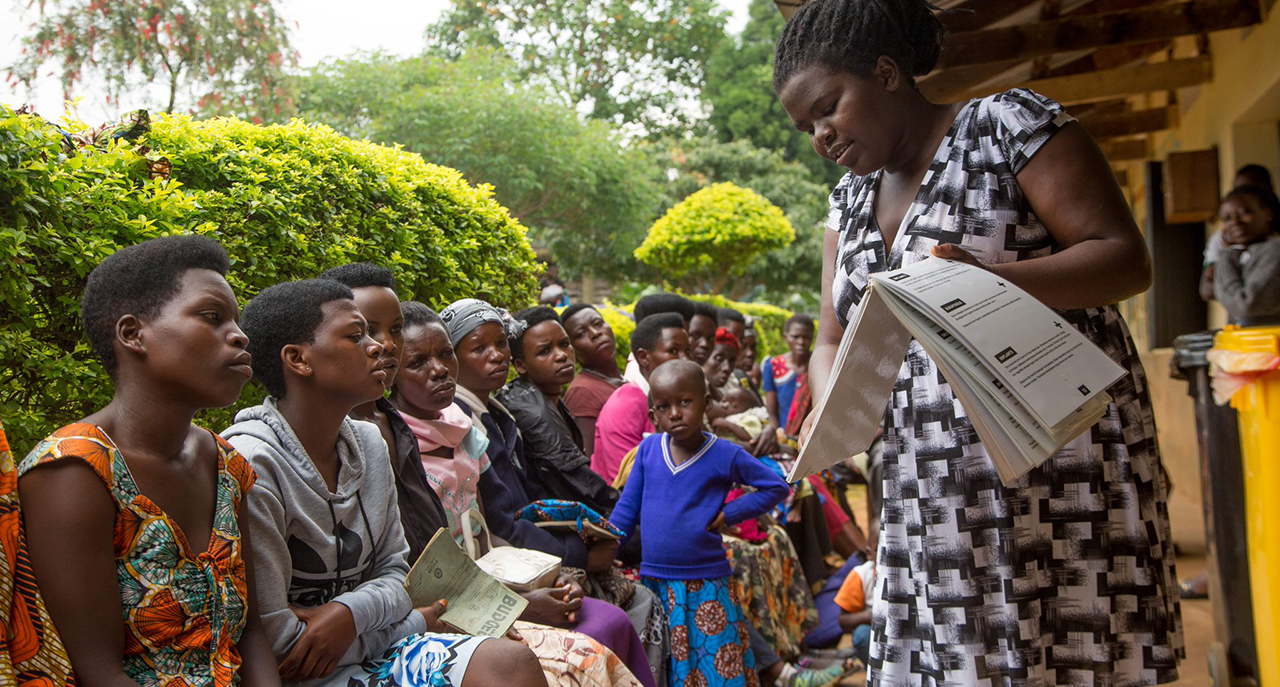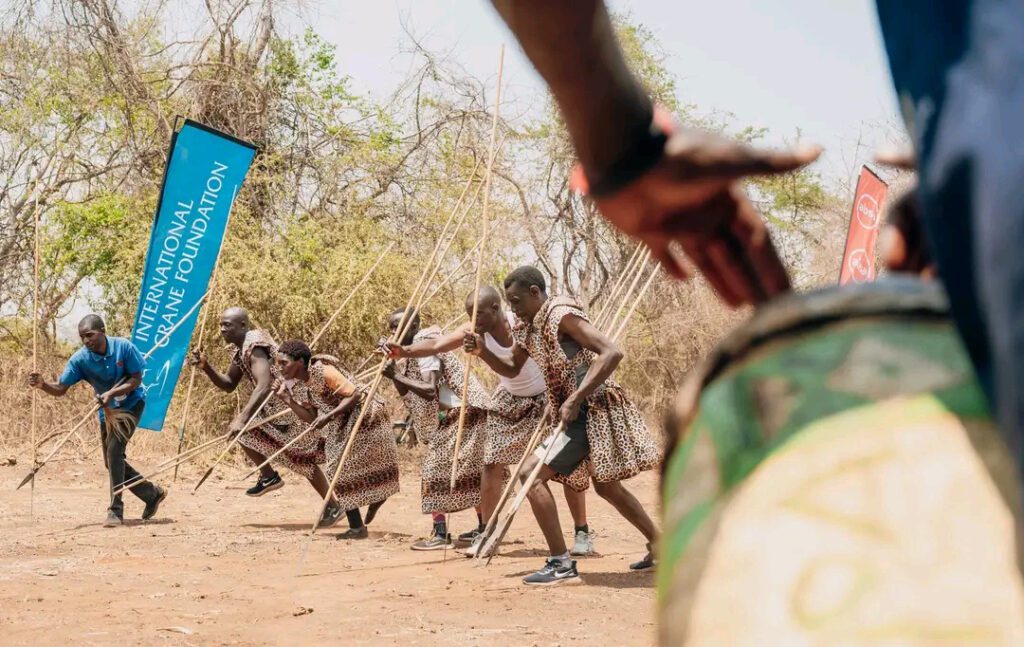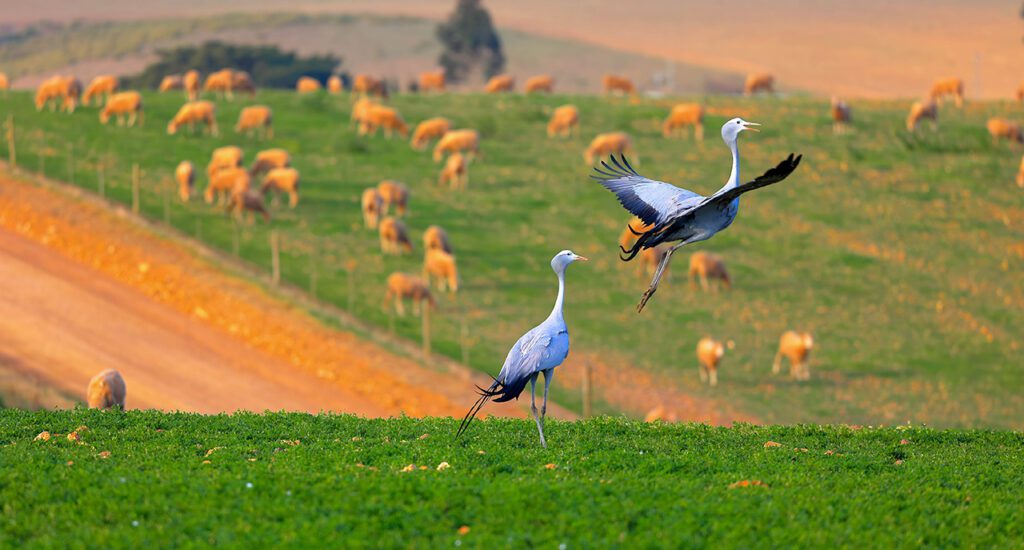Endangered Grey Crowned Crane Conservation Improves Livelihoods and Saves Wetlands Across Africa
Conservation success story to be highlighted at African-Eurasian Migratory Waterbird Agreement meeting Nov. 11-14 in Germany

Contacts: Jodi Legge, Vice President of External Affairs, International Crane Foundation; Eleanor Momberg, Communications Manager, Endangered Wildlife Trust
Nov. 6, 2025 – Human population growth and poor agricultural practices across Africa have strained critical wetland habitats, as farmers have been forced to convert wetlands to agriculture to feed their growing families and obtain the crop yields they need. When wetlands are cultivated, the loss of breeding habitats not only displaces the Endangered Grey Crowned Crane and other wildlife but also impacts the region’s water resources. The International Crane Foundation/Endangered Wildlife Trust Partnership has implemented innovative solutions for communities, protecting habitats for cranes and providing a lasting impact.
Once abundant throughout Africa, the Grey Crowned Crane’s current population is estimated at between 30,000 and 37,000 and has been decreasing. As communities increase their dependence on wetlands and their resources, cranes come into more frequent contact with people, livestock, and dogs, resulting in more time watching for potential threats and less time nesting and caring for chicks. Other serious threats include collisions with powerlines, theft of crane eggs for food, capture of cranes for illegal wildlife trade, crane poisonings, and the spread of invasive species.
The health of crane populations is an indicator of the overall health of the wetlands. In healthy wetlands with minimal agricultural encroachment, cranes have room to breed, leading to greater numbers of birds and improved productivity. Such wetlands are also in better condition to support community water requirements. This can only be achieved, though, if farming practices in the surrounding uplands are improved, and the resilience of local communities to changing climatic, social, and economic conditions is improved.
 A farm in Nandi County, Kenya, demonstrates climate-smart agriculture techniques. An avocado tree anchors the center of the garden (on the right). Sara Gavney Moore/International Crane Foundation
A farm in Nandi County, Kenya, demonstrates climate-smart agriculture techniques. An avocado tree anchors the center of the garden (on the right). Sara Gavney Moore/International Crane Foundation
The partnership’s pioneering approach to conservation starts with community-based conservation and research—first understanding the socioeconomic factors that have forced people to encroach on wetlands—and then collaborating with community groups, local governments, and other organizations to find real solutions. The conservation strategies include everything from improved landscape-level grazing management, sustainable, climate-smart agriculture programs such as vertical organic gardens, enriched buffer zones that restore riparian habitat, incorporating added livelihood opportunities, mushroom and avocado farming, and beekeeping, to securing and protecting freshwater springs that provide clean water to hundreds of families, schools, churches, and hospitals.
Morrison added: “For cranes to survive among the neglected ‘last mile’ communities of East Africa, we must continue to improve community well-being, reduce their dependency on wetlands, and increase their resilience in a changing climatic and socio-economic world.”
 Women attending a voluntary health education program in Uganda. Margaret Pyke Trust
Women attending a voluntary health education program in Uganda. Margaret Pyke Trust
The partnership’s integrated public health and safety programs provide separate latrines for boys and girls to help girls stay in school longer, and the rights-based approach to voluntary family planning and other health-related programs offer choices for women to decide how many children they want to have, and when. Results show decreased dependence on the wetlands. Additionally, peer-to-peer programmes such as farmer field schools educate community ambassadors to train others in sustainable agricultural practices, and youth education programmes teach young people about crane and wetland conservation.
“This community-based approach demonstrates how conservation can create lasting benefits not only for the Grey Crowned Crane and the biodiversity in wetlands, but also for the people who depend on these ecosystems for their livelihoods. It is not a top-down approach, but the result of genuine dialogue and collaboration with local communities and stakeholders. I am confident that this inclusive approach will, in the years ahead, strengthen both the well-being of communities and the conservation prospects of this magnificent yet endangered AEWA species in Africa,” said Jacques Trouvilliez, Executive Secretary of AEWA.
This successful approach to conservation will be shared by Kerryn Morrison, the partnership’s Vice President of Africa Programs, during the 9th Session of the Meeting of the Parties of the African-Eurasian Migratory Waterbird Agreement (AEWA MOP9) held from November 11-14 in Bonn, Germany. The Meeting of the Parties is AEWA’s principal decision-making body. The upcoming AEWA Meeting in Bonn will consider a proposal to extend the International Single Species Action Plan for the Conservation of the Grey Crowned Crane Plan for a further 12 years—an initiative first endorsed by the group in November 2016. A dedicated Grey Crowned Crane International Working Group has been established under AEWA, comprising this species’ Range States and coordinated by Morrison.
Top photo by Ondrej Prosicky


